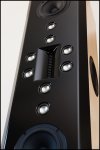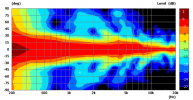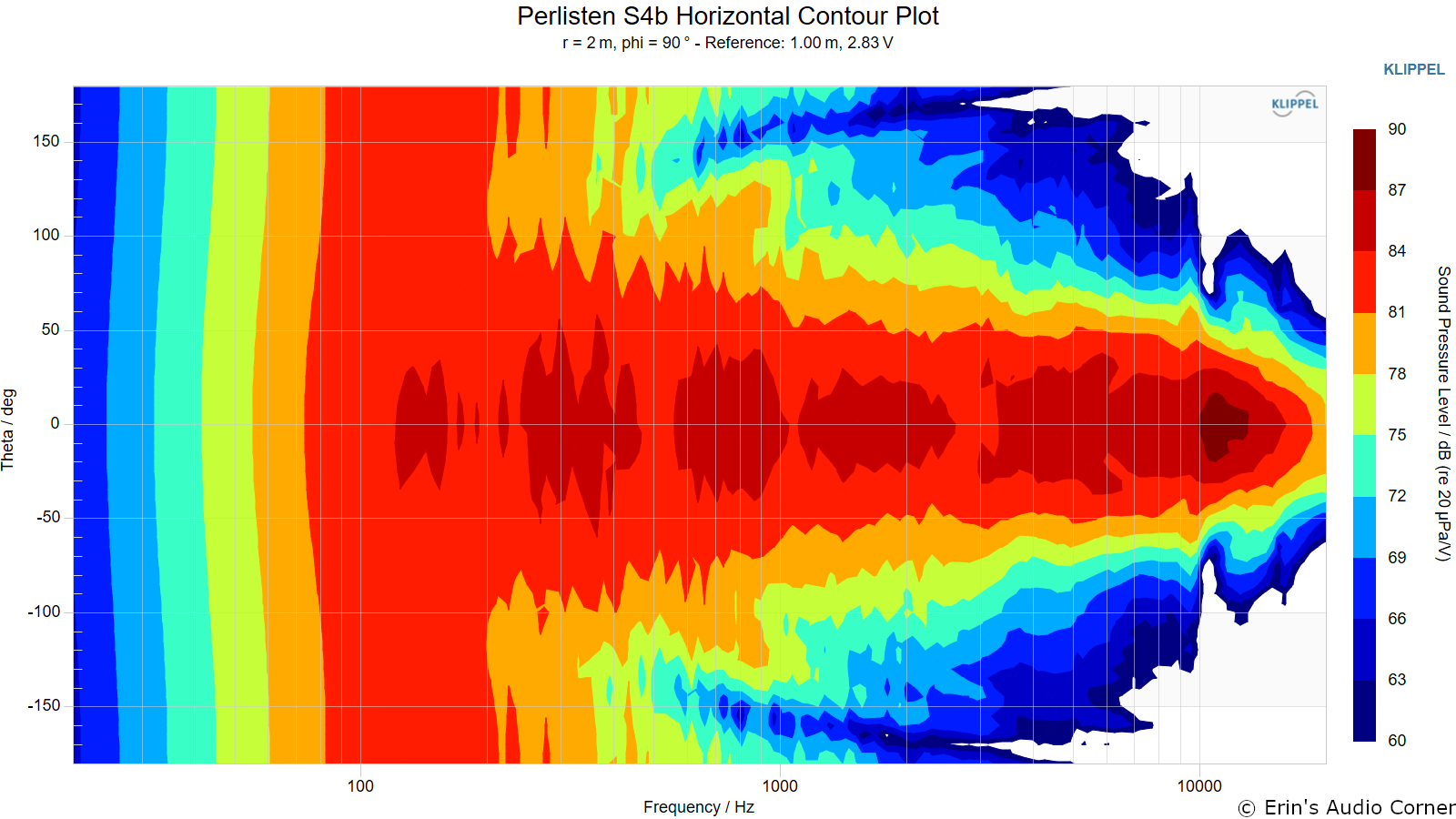-
Welcome to ASR. There are many reviews of audio hardware and expert members to help answer your questions. Click here to have your audio equipment measured for free!
You are using an out of date browser. It may not display this or other websites correctly.
You should upgrade or use an alternative browser.
You should upgrade or use an alternative browser.
Tekton style like tweeter array good idea?
- Thread starter Randolf
- Start date
ctrl
Major Contributor
However, I didn't make an effort to optimize the array. If you drive the speaker actively via DSP, there are additional opportunities to optimize the radiation pattern for the circular tweeter array.It's like a controlled crash landing. As you have shown, it's not a pretty picture
Yep, I saw the diyAudio thread. My sketch above is based on that info.One of the members did some decent analysis in that thread too.
I just couldn't find any info on the Moab or Encore speaker with the double circular arrays. But even there, you can form different groups of tweeters, allowing you to control the directivity.
Hi
Know nothing about speaker designs, my question:
What problems this array of tweeters address that can't be served by current speaker designs?
...
In the HEA, you need to show that you are different, just ... to be different and be able to sing a different tune.. Complexity, esoterica for complexity sake's but not solving real issues...
Peace.
Know nothing about speaker designs, my question:
What problems this array of tweeters address that can't be served by current speaker designs?
...
In the HEA, you need to show that you are different, just ... to be different and be able to sing a different tune.. Complexity, esoterica for complexity sake's but not solving real issues...
Peace.
Last edited:
Doenerkunde
Active Member
- Joined
- Dec 29, 2022
- Messages
- 176
- Likes
- 456
I generally find quasi-coaxial louspeakers interesting and there have been some attempts in the german DIY scene to implement such arrays with very small widerband drivers:
Monacor Raduno


 www.hifitest.de
www.hifitest.de
Franks Circular Array

FoLLgoTTs Quasikoax 1

Monacor Raduno


Monacor Raduno
Das „Andere“ zu bauen, das, welches es im Laden einfach nicht gibt, ist einer der größten Spaßfaktoren am Selbstbau. Und den meisten Spaß macht‘s, wenn selbiges dann noch so exzellente Ergebnisse liefert wie der clevere Mittelton-Revolver von Monacors Raduno
Franks Circular Array

FoLLgoTTs Quasikoax 1

Clearly, you weren't the only oneHowever, I didn't make an effort to optimize the array
thewas
Master Contributor
- Joined
- Jan 15, 2020
- Messages
- 8,217
- Likes
- 23,030
Someone can use driver arrays cleverly for example to form wide horizontal and narrow vertical radiation like this example from a DIY person who puts most "professional" loudspeaker designers to shame:



Source with full documentation: http://loudspeaker-research.de/Quasikoax 1 Documentation.pdf



Source with full documentation: http://loudspeaker-research.de/Quasikoax 1 Documentation.pdf
dasdoing
Major Contributor
guess we could throw 8381a and Danley horn in the mix, too
Yes, I forgot about this one! I think it's also over somewhere at DIYAudio. This is an excellent example of how it can be done successfully.Someone can use driver arrays cleverly for example to form wide horizontal and narrow vertical radiation like this example from a DIY person who puts most "professional" loudspeaker designers to shame:
View attachment 362630 View attachment 362631View attachment 362632
Source with full documentation: http://loudspeaker-research.de/Quasikoax 1 Documentation.pdf
I “think” it could be perfected at the cost of very complicated crossovers, probably active. The issue is now your defeating the purpose of using inexpensive components which Tekton does.IMO this is an okay idea, not a great idea.
The idea that a lower moving mass has some inherent advantage in terms of "speed" is specious. If this could be demonstrated, it would be easy to demonstrate. Don't hold your breath waiting for the stunning results proving the merits of this idea.
I think it would depend on larger drivers having different frequency responses in the treble depending on what other frequencies are playing at the same time (this would show up in IMD/multitone plots if it was a problem), and/or static vs. dynamic friction coming into play, which is considered real but rare.
That said, you can do some interesting stuff in terms of SPL / distortion by dividing the load between many tweeters as Tekton does.
Unfortunately, from what I have seen in other threads, the effect of having many tweeters in a large area is not categorically different from having a large driver reproducing the same frequencies. In other words, you still get beaming.
So, it is a trade-off like any other when it comes to speaker design. By all accounts their speakers don't sound bad in practice, even though the measurements do show the beaming in the midrange. I think depending on your opinion the trade-offs might be worth it. So I guess it's not a terrible idea, nor does it clearly beat more conventional designs.
I would much rather see lower cost opposed subwoofers, possibly like the Paradigm Signature Sub 2 but with much less expensive components computer modeled to achieve similar results.
What problems this array of tweeters address that can't be served but current speaker designs?
Ime, "ring arrays" add far more problems than they eliminate.
The basic problem with all cone/dome type speakers, is the difficulty in keeping drivers' center-to-center spacing within 1/4 WL of the frequency range they jointly cover. For ring arrays you probably replace the word difficulty with impossibility....
Take this model: the c2c of the drivers in the ring and center is probably around 4". That equates to good 1/4WL summation from about 850 Hz down.
The only way this speaker has a chance is to use the center ring driver as the sole driver covering say 1000Hz up (lower would be better). Bogus.
Plus, now there's broken WL continuity for the outer ring with no center driver bridge.
These flat baffle ring arrays take line arrays difficulties with vertical driver spacings per bandwidths covered, and essentially double them down by saying "let's make horizontal just as difficult". Lol
Collapsing the flat baffle into a waveguide, helps with ring drivers c2c spacing...but kinda mandates the ring in either a waveguide or small coax, not be too physically large.
A synergy/unity type horn, collapses the flat baffle further, definitely helps with c2c, and allows for larger drivers.
I did DIY/play with these things for a while. This one had xover frequencies designed to get best ring interplay possible.
Not bad, but measured and sounded miles below synergy builds, and even regular MTMs.
Imso, Just say no to flat baffle ring arrays
- Thread Starter
- #31
As usual there are many ways to solve a problem, this is especially true for loudspeakers since even the best of the best are rather far away from being perfect. So there is always a tradeoff involved. What makes the Tekton idea rather special (maybe good, ok or bad) to me is that that they try to use an array of tweeters as midrange drivers. Typically an array of drivers is used within the specs and intended frequency range of the individual drivers, that is not the case here. The main argument for doing this seems to be the lower mass of the tweeter diaphragms. One may also argue that this may be a little bit similar to the source point idea of coaxial or full range drivers, but I would not take this serious for the Tektion case. The arrangement of 6 drivers around a single tweeter doesn't really make it a source point like concept.Hi
Know nothing about speaker designs, my question:
What problems this array of tweeters address that can't be served but current speaker designs?
...
In the HEA, you need to show that you are different, just ... to be different and be able to sing a different tune.. Complexity, esoterica for complexity sake's but not solving real issues...
Peace.
thewas
Master Contributor
- Joined
- Jan 15, 2020
- Messages
- 8,217
- Likes
- 23,030
By the way from the commercial home hifi companies Perlisten do such in an excellent way:What makes the Tekton idea rather special (maybe good, ok or bad) to me is that that they try to use an array of tweeters as midrange drivers.

Source: https://www.perlistenaudio.com/technology/speaker-technology/


Source: https://www.erinsaudiocorner.com/loudspeakers/perlisten_s4b/
Yes but it’s not a ring it’s a line array with very close spacing in a wg . You need rare earth materials to get drivers small enough to put this close and this probably how close they actually need to be ?By the way from the commercial home hifi companies Perlisten do such in an excellent way:

Source: https://www.perlistenaudio.com/technology/speaker-technology/


Source: https://www.erinsaudiocorner.com/loudspeakers/perlisten_s4b/
Just upfront -I don't want anything to do with the drama as of late, I have never measured speakers, and have no expertise into the topic. Just a casual audio enthusiast.
I have a pair of Tekton Electron SE speakers with central Be tweeter. I have found them to have really great midrange detail and clarity, which to me is comparable to Paradigm Persona 3F towers that I also own. Of course this is just my subjective experience and as has been mentioned there are no published measurements I am aware of other than the limited ones posted by Stereophile of a few of their models.
It sounds like the manufacturer is going to publish measurements in the future. I hope that is the case, and I hope others can evaluate them on their own to see if those reported measurements stack up.
I have a pair of Tekton Electron SE speakers with central Be tweeter. I have found them to have really great midrange detail and clarity, which to me is comparable to Paradigm Persona 3F towers that I also own. Of course this is just my subjective experience and as has been mentioned there are no published measurements I am aware of other than the limited ones posted by Stereophile of a few of their models.
It sounds like the manufacturer is going to publish measurements in the future. I hope that is the case, and I hope others can evaluate them on their own to see if those reported measurements stack up.
- Thread Starter
- #35
Thanks for this link, interesting design, but when looking closer at it rather different. It's using a specialized tweeter/midrange driver basically consisting of 3 drivers and a waveguide specially designed for this scenario. Also the crossover points look rather "normal" to me, quite low for small dome drivers but still significantly higher to what Tektion seems to use.
thewas
Master Contributor
- Joined
- Jan 15, 2020
- Messages
- 8,217
- Likes
- 23,030
Yes but it’s not a ring it’s a line array with very close spacing in a wg
My reply was to the usage as an array the of tweeters as midrange drivers, Perlisten calls them midrange drivers but in the end they are 1" domes which can be crossed an octave lower than typical ones, so around 1 kHz.Thanks for this link, interesting design, but when looking closer at it rather different. It's using a specialized tweeter/midrange driver basically consisting of 3 drivers and a waveguide specially designed for this scenario. Also the crossover points look rather "normal" to me, quite low for small dome drivers but still significantly higher to what Tektion seems to use.
- Thread Starter
- #37
Interesting, does Tekton specify any crossover points in the manual? Maye the 5 inch midrange drivers of the Electron SE help to not having the tweeter array play that low, making it a more conventional design?Just upfront -I don't want anything to do with the drama as of late, I have never measured speakers, and have no expertise into the topic. Just a casual audio enthusiast.
I have a pair of Tekton Electron SE speakers with central Be tweeter. I have found them to have really great midrange detail and clarity, which to me is comparable to Paradigm Persona 3F towers that I also own. Of course this is just my subjective experience and as has been mentioned there are no published measurements I am aware of other than the limited ones posted by Stereophile of a few of their models.
It sounds like the manufacturer is going to publish measurements in the future. I hope that is the case, and I hope others can evaluate them on their own to see if those reported measurements stack up.
Last edited:
Interesting, does Tekton specify any crossover points in the manual? Maye the 5 inch midrange drivers of the Electron SE help to not having the tweeter array play that low, making it a more conventional design?
They do not but I would be equally interested in knowing them
- Thread Starter
- #39
Since I brought up the question if the money wouldn't be better spent on 2 high end midrange drivers than on a huge number of tweeters: Here is an extreme example from an expensive Tekton model: https://tektondesign.com/product/full-range-speakers/flagship/ulfberht/#color
The base price is 9830$, but they offer an optional upgrade to Beryllium tweeter arrays (30 drivers) for 11970$. Is this really a good idea? This beams the price of the speaker into the very high end category like a KEF Blade 2 Meta. The upgrade price is indeed somewhat reasonable since Beryllium tweeters are really expensive (https://www.soundimports.eu/en/scan-speak-d2908-714000.html)
The base price is 9830$, but they offer an optional upgrade to Beryllium tweeter arrays (30 drivers) for 11970$. Is this really a good idea? This beams the price of the speaker into the very high end category like a KEF Blade 2 Meta. The upgrade price is indeed somewhat reasonable since Beryllium tweeters are really expensive (https://www.soundimports.eu/en/scan-speak-d2908-714000.html)
Without a long, boring technical breakdown, the philosophical issue with these designs is that they focus on solving one or two problems and sacrifice everything else. Panels reduce crossover complexity (some of the time) and moving mass (for LF anyway) and sacrifice any kind of smooth spatial radiation and bass. Mangers are designed to be very wide band and sacrifice bass and efficiency. Plasma tweeters, I have no idea, they have no moving mass. I almost respect the plasma tweeters as art simply because they are such an absurd product.I read this with interest. Would you be able to give a brief explanation as to why panels, mangers, and plasma tweeters are fundamentally flawed?
If you want an esoteric technology that works, look at unity horns and cardioids. The big genelecs sort of combine both technologies which is why they are for me the biggest and baddest speakers you can buy.
Similar threads
- Replies
- 169
- Views
- 14K
- Replies
- 2
- Views
- 1K
- Replies
- 1
- Views
- 515
- Replies
- 5
- Views
- 1K
- Replies
- 30
- Views
- 3K
